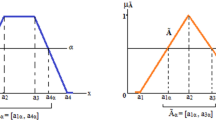Abstract
Rare event probability estimation imposes serious difficulties to the conventional simulation methods like crude Monte Carlo. Several methods have been put forward to address this issue. Line sampling, directional simulation, importance sampling and subset simulation are more known among other methods. This paper aims at improving the line sampling method. The proposed method iteratively adapts the line sampling procedure to the limit state surface and at the end yields an estimation of the failure probability with the required coefficient of variation. The proposed method is compared to the conventional line sampling via well-known academic problems. The results show considerable improvement over the conventional line sampling method.




Similar content being viewed by others
References
Au SK, Beck JL (2001) Estimation of small failure probabilities in high dimensions by subset simulation. Probab Eng Mech 16(4):263–277
Au S, Beck J (2003) Important sampling in high dimensions. Struct Saf 25(2):139–163
Bjerager P (1990) On computation methods for structural reliability analysis. Struct Saf 9(2):79–96
Der Kiureghian A (2008) Analysis of structural reliability under parameter uncertainties. Probab Eng Mech 23(4):351–358
Ditlevsen O, Bjerager P, Olesen R, Hasofer AM (1988) Directional simulation in Gaussian processes. Probab Eng Mech 3(4):207–217
Ditlevsen O, Melchers RE, Gluver H (1990) General multi-dimensional probability integration by directional simulation. Comput Struct 36(2):355–368
Engelund S, Rackwitz R (1993) A benchmark study on importance sampling techniques in structural reliability. Struct Saf 12(4):255–276
Hammersley J, Handscomb D (1964) Monte Carlo methods. Methuen & Co Ltd, London
Jahani E, Shayanfar M, Barkhordari M (2013) A new adaptive importance sampling Monte Carlo method for structural reliability. KSCE J Civ Eng 17(1):210–215
Kaveh A, Massoudi M, Ghanoonini Bagha M (2014) Structural reliability analysis using charged system search algorithm. Iran J Sci Technol Trans Civ Eng 38(C2):439
Koutsourelakis PS (2004) Reliability of structures in high dimensions. Part II. Theoretical validation. Probab Eng Mech 19(4):419–423
Koutsourelakis PS, Pradlwarter HJ, Schuëller GI (2004) Reliability of structures in high dimensions, part I: algorithms and applications. Probab Eng Mech 19(4):409–417
Kurtz N, Song J (2013) Cross-entropy-based adaptive importance sampling using Gaussian mixture. Struct Saf 42:35–44
Lu Z, Song S, Yue Z, Wang J (2008) Reliability sensitivity method by line sampling. Struct Saf 30(6):517–532
Melchers RE (1989) Importance sampling in structural systems. Struct Saf 6(1):3–10
Metropolis N, Ulam S (1949) The Monte Carlo method. J Am Stat Assoc 44(247):335–341
Mirzaie F, Mahsuli M, Ghannad MA (2016) Probabilistic analysis of soil-structure interaction effects on the seismic performance of structures. Earthq Eng Struct Dyn 46(4):641–660
Patelli E, Panayirci HM, Broggi M, Goller B, Beaurepaire P, Pradlwarter HJ, Schuëller GI (2012) General purpose software for efficient uncertainty management of large finite element models. Finite Elem Anal Des 51:31–48
Pradlwarter HJ, Schuëller GI, Koutsourelakis PS, Charmpis DC (2007) Application of line sampling simulation method to reliability benchmark problems. Struct Saf 29(3):208–221
Shayanfar MA, Barkhordari MA, Ghanooni-Bagha M (2015) Estimation of corrosion occurrence in RC structure using reliability based PSO optimization. Period Polytech Civ Eng 59(4):531–542
Song S, Lu Z, Qiao H (2009) Subset simulation for structural reliability sensitivity analysis. Reliab Eng Syst Saf 94(2):658–665
Zhao H, Yue Z, Liu Y, Gao Z, Zhang Y (2015) An efficient reliability method combining adaptive importance sampling and Kriging metamodel. Appl Math Model 39(7):1853–1866
Zuev KM (2021) Subset simulation method for rare event estimation: an introduction. In: Beer M, Kougioumtzoglou IA, Patelli E, Au IS-K (eds) Encyclopedia of earthquake engineering. Springer, Berlin
Author information
Authors and Affiliations
Corresponding author
Appendix
Appendix
Here we present the proof of Eqs. (9) to (11). It is evident that changing the important direction does not affect the probability estimation, so averaging the reliability results derived from different important directions in different iterations also delivers an estimation of the failure probability [Eq. (9)]. We choose the averaging weights so as to minimize the coefficient of variation for the averaged estimation. Assuming the independence of estimations drawn from different iterations, the standard deviation of the averaged estimation is:
Dividing both sides by P f produces Eq. (11). By application of the Lagrange multiplier method and applying the constraint of \(\mathop \sum \limits_{i = 1}^{k} w_{i} = 1\), the optimal weights will be derived as Eq. (10).
Derivation of Eq. (7).
We know that for identically distributed and independent random variables X i , the variance of their arithmetic mean \(\bar{X}\) is:
The variance of all the Xi random variables is equal to each other and is denoted by the term Var(X). By definition of Var(X) as \({\text{Var}}\left( X \right) = E\left[ {\left( {X - E\left( X \right)} \right)^{2} } \right]\), it can be estimated as:
Thus, we get an estimation for the variance of \(\bar{X}\) as:
To derive the Eq. (7), it is sufficient to replace \(X_{i}\) by \(\varPhi \left( { - \left| {c_{i} } \right|} \right)\).
Rights and permissions
About this article
Cite this article
Shayanfar, M.A., Barkhordari, M.A., Barkhori, M. et al. An Adaptive Line Sampling Method for Reliability Analysis. Iran J Sci Technol Trans Civ Eng 41, 275–282 (2017). https://doi.org/10.1007/s40996-017-0070-3
Received:
Accepted:
Published:
Issue Date:
DOI: https://doi.org/10.1007/s40996-017-0070-3




